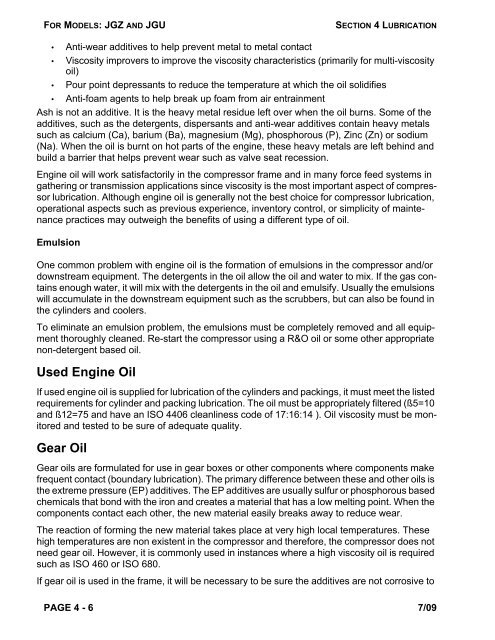Heavy Duty Balanced Opposed Compressors - Ariel Corporation
Heavy Duty Balanced Opposed Compressors - Ariel Corporation
Heavy Duty Balanced Opposed Compressors - Ariel Corporation
Create successful ePaper yourself
Turn your PDF publications into a flip-book with our unique Google optimized e-Paper software.
FOR MODELS: JGZ AND JGU SECTION 4 LUBRICATION<br />
• Anti-wear additives to help prevent metal to metal contact<br />
• Viscosity improvers to improve the viscosity characteristics (primarily for multi-viscosity<br />
oil)<br />
• Pour point depressants to reduce the temperature at which the oil solidifies<br />
• Anti-foam agents to help break up foam from air entrainment<br />
Ash is not an additive. It is the heavy metal residue left over when the oil burns. Some of the<br />
additives, such as the detergents, dispersants and anti-wear additives contain heavy metals<br />
such as calcium (Ca), barium (Ba), magnesium (Mg), phosphorous (P), Zinc (Zn) or sodium<br />
(Na). When the oil is burnt on hot parts of the engine, these heavy metals are left behind and<br />
build a barrier that helps prevent wear such as valve seat recession.<br />
Engine oil will work satisfactorily in the compressor frame and in many force feed systems in<br />
gathering or transmission applications since viscosity is the most important aspect of compressor<br />
lubrication. Although engine oil is generally not the best choice for compressor lubrication,<br />
operational aspects such as previous experience, inventory control, or simplicity of maintenance<br />
practices may outweigh the benefits of using a different type of oil.<br />
Emulsion<br />
One common problem with engine oil is the formation of emulsions in the compressor and/or<br />
downstream equipment. The detergents in the oil allow the oil and water to mix. If the gas contains<br />
enough water, it will mix with the detergents in the oil and emulsify. Usually the emulsions<br />
will accumulate in the downstream equipment such as the scrubbers, but can also be found in<br />
the cylinders and coolers.<br />
To eliminate an emulsion problem, the emulsions must be completely removed and all equipment<br />
thoroughly cleaned. Re-start the compressor using a R&O oil or some other appropriate<br />
non-detergent based oil.<br />
Used Engine Oil<br />
If used engine oil is supplied for lubrication of the cylinders and packings, it must meet the listed<br />
requirements for cylinder and packing lubrication. The oil must be appropriately filtered (ß5=10<br />
and ß12=75 and have an ISO 4406 cleanliness code of 17:16:14 ). Oil viscosity must be monitored<br />
and tested to be sure of adequate quality.<br />
Gear Oil<br />
Gear oils are formulated for use in gear boxes or other components where components make<br />
frequent contact (boundary lubrication). The primary difference between these and other oils is<br />
the extreme pressure (EP) additives. The EP additives are usually sulfur or phosphorous based<br />
chemicals that bond with the iron and creates a material that has a low melting point. When the<br />
components contact each other, the new material easily breaks away to reduce wear.<br />
The reaction of forming the new material takes place at very high local temperatures. These<br />
high temperatures are non existent in the compressor and therefore, the compressor does not<br />
need gear oil. However, it is commonly used in instances where a high viscosity oil is required<br />
such as ISO 460 or ISO 680.<br />
If gear oil is used in the frame, it will be necessary to be sure the additives are not corrosive to<br />
PAGE 4 - 6 7/09















